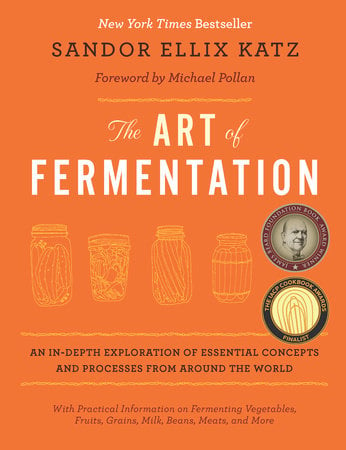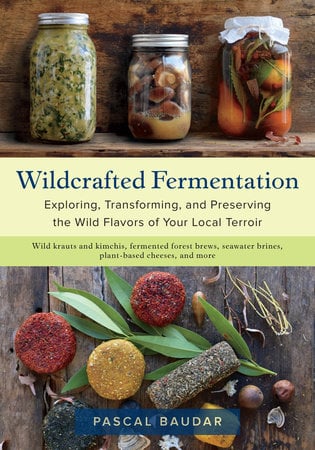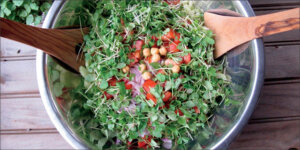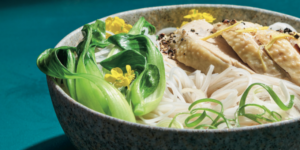How to Make Groundnut Sweet Potato Stew

It’s officially stew season! Warm yourself up from the inside out by making groundnut sweet potato stew, a favorite of fermentation revivalist Sandor Katz.
The following is an excerpt from Wild Fermentation by Sandor Katz. It has been adapted for the web.
Fermenting Sweet Potatoes for Stew
MaxZine, who lives down the road at IDA, another queer community 10 miles away, has encouraged my fermentation fetish for years, mostly by organizing major feasts around fermented goodies. One year it was tempeh Reuben sandwiches for two hundred people. Ethiopian nights have become an annual event. I make injera and t’ej, Ethiopian-style honey wine, and he makes the rest.
This dish is one he adapted from the cookbook Sundays at Moosewood Restaurant. “Groundnut” is what the peanut (Arachis hypogaea) is called in English-speaking regions of Africa. In Africa, yams would probably be used rather than sweet potatoes, but MaxZine grows amazing sweet potatoes, and they are what is generally found (and often confused with yams) in this country.
RECIPE: Groundnut Sweet Potato Stew
This recipe is augmented by Jerusalem artichokes, which are not an African vegetable at all, but a beloved winter tradition among many American gardeners. The Jerusalem artichokes add a lovely varied texture to this dish. If you don’t have Jerusalem artichokes available, just proceed without them.
TIMEFRAME:
30 to 40 minutes
INGREDIENTS (for 6 to 8 servings):
- 2 cups/500 milliliters chopped onions
- 2 tablespoons/30 milliliters vegetable oil
- 3 cups/750 milliliters cubed sweet potatoes
- 3 cloves garlic, chopped
- 1⁄2 teaspoon/2 milliliters cayenne
- 2 teaspoons/10 milliliters ginger
- 1 teaspoon/5 milliliters cumin
- 1 tablespoon/15 milliliters paprika
- 1 tablespoon/15 milliliters fenugreek
- 1 teaspoon/5 milliliters salt
- Dash each cinnamon and clove
- 4 cups/1 liter fresh or canned tomatoes
- 1 cup/250 milliliters apple juice, or 1 cup/250 milliliters water plus 1 tablespoon/15 milliliters honey
- 3⁄4 cup/185 milliliters peanut butter
- 2 cups/500 milliliters sliced Jerusalem artichokes
- 3 cups/750 milliliters cabbage or other dark leafy greens, chopped
PROCESS:
- In a good-sized, deep cooking pot, sauté the onions in oil until translucent, about 5 minutes.
- Add sweet potatoes, garlic, and cayenne; sauté, covered, for 5 minutes.
- Add all the other ingredients except the peanut butter, Jerusalem artichokes, and greens. Bring to a boil, reduce heat, and simmer about 10 minutes.
- Remove 1/2 to 1 cup (125 to 250 milliliters) of the hot liquid from the pot, and combine it with the peanut butter into a creamy paste. Add the thinned peanut butter, Jerusalem artichokes, and greens to the pot, and simmer about 5 more minutes, until the vegetables are tender. Add more liquid if the stew is too thick, and adjust seasonings to taste.
- Serve with injera and/or over millet.
Recommended Reads
Recent Articles
Miso soup is the perfect, soul-healing meal. Not only does this soup taste great, it also has amazing health benefits!
Read MoreDoes the cold weather have you dreaming about fresh greens and colorful salad? Grow and harvest sprouts indoors to make those dreams a reality!
Read MoreWinter just got cozier! Our simple & nourishing soup is just what you need to cozy up on chilly days or nights! Delicious and nutritious, this soup is perfect for the whole family.
Read MoreIndulge in the sweet aroma of these pastry-wrapped pears! Easy to make and stunning to serve, these pastry-wrapped pears are a game-changer.
Read MoreDitch boring snacks and upgrade to adorable fruit & veggie treats you’ll love! Brighten up snack time this winter using fruits and veggies we all know and love. Can you resist taking a bite of these cuties?
Read More









